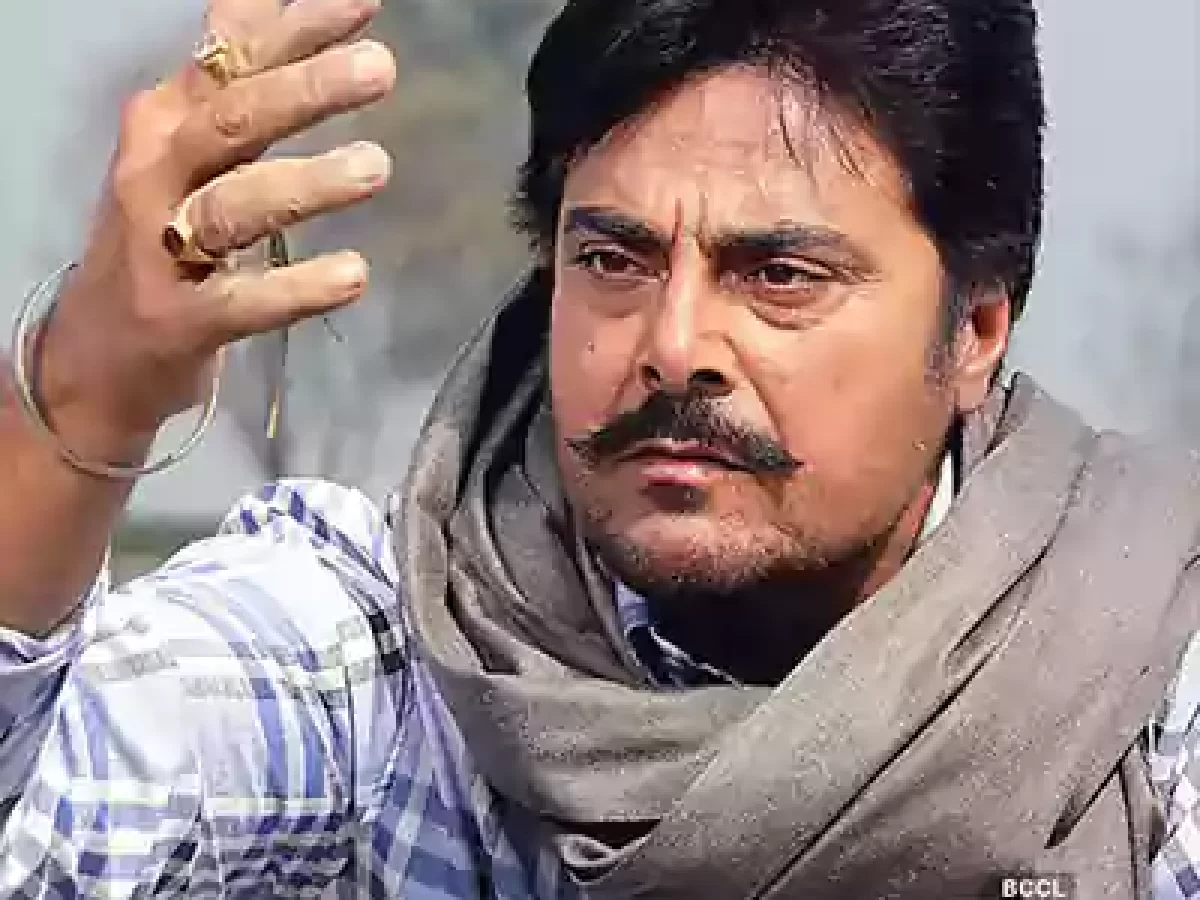Kulwinder Singh Gill, popularly known as Gugu Gill Biography, born on January 14, 1960, in Mahni Khera village near Malout, Muktsar, Punjab, is a veteran Indian actor in Punjabi cinema. Known as a 1990s Pollywood icon alongside Yograj Singh, unka safar ek gaon se Punjabi cinema ke shikhar tak ka hai. With over 65тАУ70 films, heтАЩs celebrated for his versatile roles, from villains to heroes. Yeh Punjabi ka sher has left an indelible mark with films like Gabhroo Punjab Da.┬а
┬а
Early Life and Education
Born into a Jatt Sikh family in Mahni Khera, Gugu hails from Ghall Khurd, Moga district. His father, grandfather, and brother served as sarpanchs, reflecting a legacy of community leadership. Yeh parivaarik background unke disciplined approach ka base bana. Details about his formal education are scarce, but he pursued acting with passion, likely learning through practical experience in PunjabтАЩs vibrant cultural scene. His early exposure to village life shaped his authentic portrayal of rustic Punjabi characters, making him a household name.

Acting Career and First Movie (Gugu Gill Biography)
Gugu debuted with a minor role in the blockbuster Putt Jattan De (1983), appearing in a dog fight scene alongside Shatrughan Sinha and Dharmendra. His first major role was as the villain Jagroop тАШJagguтАЩ in Gabhroo Punjab Da (1986), a milestone that earned him the Best Villain Award. He starred in iconic films like:
- Chhora Haryane Da (1985)
- Jatt Te Zameen (1989)
- Qurbani Jatt Di (1990)
- Anakh Jattan Di (1990)
- Jatt Jeona Mour (1991)
- Yaaran Naal Baharan (1991)
- Jorr Jatt Da (1991)
- Dil Da Mamla (1992)
- Putt Sardaran De (1992)
- Lalkara Jatti Da (1993)
- Baaghi Soormey (1993)
- Mirza Jatt (1993)
- Vairi (1994)
- Mera Punjab (1994)
- Pratigya (1995)
- Zaildaar (1995)
- Smuggler (1996, Hindi debut)
- Sardari (1997)
- Rustam-e-Hind (2006)
- Mehndi Wale Hath (2006)
- Vidroh (2007)
- Mera Pind (2008)
- Heer Ranjha (2009)
- Ik Kudi Punjab Di (2010)
- Kabaddi Ikk Mohabbat (2010)
- Ajj De Ranjhe (2012)
- Jatt Boys Putt Jattan De (2013)
- Shareek (2015)
- Dildariyaan (2015)
- Sardar Saab (2017)
- Lahoriye (2017)
- Khido Khundi (2018)
- Qismat (2018)
- Bhajjo Veero Ve (2018)
- Dulla Vaily (2019)
- Lukan Michi (2019)
- Jaddi Sardar (2019)
- Aasra (2019)
- Jora: The Second Chapter (2020)
- Shikaari (2021)
- Oye Makhna (2022)
His collaborations with director Ravinder Ravi in 7тАУ8 films, including Anakh Jattan Di and Jatt Jeona Mour, were massive hits. He won the Lifetime Achievement Award at the 2013 PTC Punjabi Film Awards.
┬а
Music Career and First Song
Gugu Gill is primarily an actor, not a singer, so he has no solo songs or albums. His films feature popular tracks, but he doesnтАЩt sing them. The first notable song associated with his work is Jatt Jeona Mour (1991) title track, sung by Mohammad Sadiq, not Gugu. Other film songs include Dalerian (Jora: The Second Chapter, 2020, sung by Singga), Bhajjo Veero Ve title track (2018, sung by Gurshabad), and Lukan Michi tracks (2019, sung by Preet Harpal). Yeh gaane unke films ka vibe badhate hain, but GuguтАЩs contribution remains acting-focused. He earns no direct music income.
┬а
Awards and Recognition
Gugu won the Best Villain Award for Gabhroo Punjab Da (1986) and the Lifetime Achievement Award at the 2013 PTC Punjabi Film Awards for his contributions to Pollywood. The Tribune praised his intense roles, while fans like Ghulam Abbas Hunjra from Pakistan call him тАЬthe best Punjabi actorтАЭ for Jatt Jeona Mour. Times of India lauded his fiery chemistry with Yograj Singh in Lukan Michi (2019). Yeh accolades unke iconic status ko cement karte hain.
┬а
Family: Wife and Children
Gugu is married, but his wifeтАЩs name is not publicly disclosed, reflecting his private nature. He has two sons, Guramrit Singh Gill, who served as PunjabтАЩs youngest sarpanch, and Gurjot Singh Gill. He also has a grandson, Zorawar Gill. Yeh parivaarik legacy unke village leadership ka hissa hai, with his father, grandfather, and brother also serving as sarpanchs in Mahni Khera.
┬а
Net Worth and Income
GuguтАЩs net worth is estimated at $1тАУ2 million (тВ╣7тАУ14 crore) as of 2022, earned through acting (тВ╣5тАУ10 lakh per film) and endorsements. His annual income is тВ╣50тАУ80 lakh, with monthly earnings of тВ╣4тАУ7 lakh. Unlike singers, he has no music revenue but benefits from film royalties and appearances. His philanthropy includes supporting local causes in Muktsar, aligning with his village roots. Yeh financial stability unki long career ka result hai.
┬а
Properties and Investments
Gugu owns a house in Mahni Khera, valued at тВ╣1тАУ2 crore, and likely properties in Malout or Chandigarh, though details are private. His investments are modest, focusing on real estate in Punjab, given his familyтАЩs sarpanch background. No confirmed business ventures like production houses exist, unlike peers like Amrinder Gill. He reportedly owns a modest car, possibly a Toyota, reflecting his simple lifestyle. Yeh assets unki grounded nature aur village connection dikhate hain.
┬а
Acting Classes and Theater
Gugu has no documented formal acting classes, likely learning through on-set experience and collaboration with directors like Ravinder Ravi. His theater involvement is minimal, but his early roles in action-packed films like Putt Jattan De required stage-like intensity. His ability to portray villains and heroes, as seen in Badla Jatti Da and Anakh Jattan Di, reflects a natural talent honed over decades. Yeh practical training unke powerful performances ka secret hai.
┬а
Social Media and Public Image
Gugu maintains a low social media presence, with no verified Instagram or Twitter accounts, reflecting his private persona. Fans on platforms like Ranker upvote Badla Jatti Da and Putt Jattan De as his best films, praising his commanding screen presence. His 2019 Lukan Michi role with B.N. Sharma was a comedic hit, showing his versatility. Times of India noted his vibrant role in Oye Makhna (2022) with Ammy Virk. Yeh fan love unke authentic acting ka proof hai.
рдХреБрд▓рд╡рд┐рдВрджрд░ рд╕рд┐рдВрд╣ рдЧрд┐рд▓, рдЬрд┐рдиреНрд╣реЗрдВ рдЧреБрдЧреБ рдЧрд┐рд▓ рдХреЗ рдирд╛рдо рд╕реЗ рдЬрд╛рдирд╛ рдЬрд╛рддрд╛ рд╣реИ, рдХрд╛ рдЬрдиреНрдо 14 рдЬрдирд╡рд░реА 1960 рдХреЛ рдореБрдХреНрддрд╕рд░, рдкрдВрдЬрд╛рдм рдХреЗ рдорд╛рд╣рдиреА рдЦреЗрдбрд╝рд╛ рдЧрд╛рдВрд╡ рдореЗрдВ рд╣реБрдЖред рд╡реЗ рдкрдВрдЬрд╛рдмреА рд╕рд┐рдиреЗрдорд╛ рдХреЗ рджрд┐рдЧреНрдЧрдЬ рдЕрднрд┐рдиреЗрддрд╛ рд╣реИрдВ, рдЬрд┐рдиреНрд╣реЗрдВ 1990 рдХреЗ рджрд╢рдХ рдХреЗ рдкреЙрд▓реАрд╡реБрдб рдЖрдЗрдХрди рдХреЗ рд░реВрдк рдореЗрдВ рдпреЛрдЧрд░рд╛рдЬ рд╕рд┐рдВрд╣ рдХреЗ рд╕рд╛рде рдкрд╣рдЪрд╛рди рдорд┐рд▓реАред рдЧрд╛рдВрд╡ рд╕реЗ рд╕рд┐рдиреЗрдорд╛ рдХреЗ рд╢рд┐рдЦрд░ рддрдХ рдХрд╛ рдЙрдирдХрд╛ рд╕рдлрд░ рдкреНрд░рддрд┐рднрд╛ рдФрд░ рдореЗрд╣рдирдд рд╕реЗ рднрд░рд╛ рд╣реИред 65тАУ70 рд╕реЗ рдЕрдзрд┐рдХ рдлрд┐рд▓реНрдореЛрдВ рдореЗрдВ рдЙрдирдХреЗ рдЦрд▓рдирд╛рдпрдХ рдФрд░ рдирд╛рдпрдХ рдХреЗ рдХрд┐рд░рджрд╛рд░реЛрдВ рдиреЗ рдЙрдиреНрд╣реЗрдВ рдкрдВрдЬрд╛рдмреА рджрд░реНрд╢рдХреЛрдВ рдХрд╛ рдЪрд╣реЗрддрд╛ рдмрдирд╛рдпрд╛ред
рдкреНрд░рд╛рд░рдВрднрд┐рдХ рдЬреАрд╡рди рдФрд░ рд╢рд┐рдХреНрд╖рд╛
рдЬрд╛рдЯ рд╕рд┐рдЦ рдкрд░рд┐рд╡рд╛рд░ рдореЗрдВ рдЬрдиреНрдореЗ рдЧреБрдЧреБ рдХрд╛ рдкрд░рд┐рд╡рд╛рд░ рдШрд▓реНрд▓ рдЦреБрд░реНрдж, рдореЛрдЧрд╛ рд╕реЗ рд╣реИред рдЙрдирдХреЗ рдкрд┐рддрд╛, рджрд╛рджрд╛ рдФрд░ рднрд╛рдИ рд╕рд░рдкрдВрдЪ рд░рд╣реЗ, рдЬреЛ рдЙрдирдХреА рд╕рд╛рдореБрджрд╛рдпрд┐рдХ рдиреЗрддреГрддреНрд╡ рдХреА рд╡рд┐рд░рд╛рд╕рдд рдХреЛ рджрд░реНрд╢рд╛рддрд╛ рд╣реИред рдорд╛рд╣рдиреА рдЦреЗрдбрд╝рд╛ рдореЗрдВ рдкрд▓реЗ-рдмрдврд╝реЗ, рдЙрдиреНрд╣реЛрдВрдиреЗ рдЧрд╛рдВрд╡ рдХреА рд╕рдВрд╕реНрдХреГрддрд┐ рдХреЛ рдЖрддреНрдорд╕рд╛рдд рдХрд┐рдпрд╛ред рдЙрдирдХреА рдФрдкрдЪрд╛рд░рд┐рдХ рд╢рд┐рдХреНрд╖рд╛ рдХреА рдЬрд╛рдирдХрд╛рд░реА рд╕реАрдорд┐рдд рд╣реИ, рд▓реЗрдХрд┐рди рдкрдВрдЬрд╛рдм рдХреА рд╕рд╛рдВрд╕реНрдХреГрддрд┐рдХ рдЧрддрд┐рд╡рд┐рдзрд┐рдпреЛрдВ рдореЗрдВ рднрд╛рдЧреАрджрд╛рд░реА рдиреЗ рдЙрдирдХреЗ рдЕрднрд┐рдирдп рдХреА рдиреАрдВрд╡ рд░рдЦреАред рдпрд╣ рджреЗрд╣рд╛рддреА рдкреГрд╖реНрдарднреВрдорд┐ рдЙрдирдХреЗ рдХрд┐рд░рджрд╛рд░реЛрдВ рдХреА рдкреНрд░рд╛рдорд╛рдгрд┐рдХрддрд╛ рдореЗрдВ рдЭрд▓рдХрддреА рд╣реИред
рдХрд░рд┐рдпрд░ рдФрд░ рдкрд╣рд▓реА рдлрд┐рд▓реНрдо
рдЧреБрдЧреБ рдиреЗ 1983 рдореЗрдВ рдмреНрд▓реЙрдХрдмрд╕реНрдЯрд░ рдкреБрддреНрдд рдЬрдЯреНрдЯрд╛рдВ рджреЗ рдореЗрдВ рдЫреЛрдЯреА рднреВрдорд┐рдХрд╛ (рдбреЙрдЧ рдлрд╛рдЗрдЯ рд╕реАрди) рд╕реЗ рдбреЗрдмреНрдпреВ рдХрд┐рдпрд╛ред рдЙрдирдХреА рдкрд╣рд▓реА рдкреНрд░рдореБрдЦ рднреВрдорд┐рдХрд╛ рдЧрднрд░реВ рдкрдВрдЬрд╛рдм рджрд╛ (1986) рдореЗрдВ рдЦрд▓рдирд╛рдпрдХ рдЬрдЧрд░реВрдк тАШрдЬрдЧреНрдЧреВтАЩ рдХреА рдереА, рдЬрд┐рд╕рдХреЗ рд▓рд┐рдП рдЙрдиреНрд╣реЗрдВ рдмреЗрд╕реНрдЯ рд╡рд┐рд▓реЗрди рдЕрд╡реЙрд░реНрдб рдорд┐рд▓рд╛ред рдЙрдирдХреА рдкреНрд░рдореБрдЦ рдлрд┐рд▓реНрдореЗрдВ рд╣реИрдВ: рдЬрдЯреНрдЯ рдЬрд┐рдпреЛрдирд╛ рдореМрдбрд╝ (1991), рдЕрдирдЦ рдЬрдЯреНрдЯрд╛рдВ рджреА (1990), рдХреБрд░реНрдмрд╛рдиреА рдЬрдЯреНрдЯ рджреА (1990), рд▓рд╛рд▓рдХрд╛рд░рд╛ рдЬрдЯреНрдЯреА рджрд╛ (1993), рдореЗрд░рд╛ рдкрдВрдЬрд╛рдм (1994), рдореЗрд╣рдВрджреА рд╡рд╛рд▓реЗ рд╣рд╛рде (2006), рд▓рд╣реМрд░рд┐рдП (2017), рдХрд┐рд╕реНрдордд (2018), рдФрд░ рдУрдП рдордЦрдирд╛ (2022)ред рд░рд╡рд┐рдВрджрд░ рд░рд╡рд┐ рдХреЗ рд╕рд╛рде рдЙрдирдХреА 7тАУ8 рдлрд┐рд▓реНрдореЗрдВ рд╕реБрдкрд░рд╣рд┐рдЯ рд░рд╣реАрдВред
рд╕рдВрдЧреАрдд рдФрд░ рдкрд░рд┐рд╡рд╛рд░
рдЧреБрдЧреБ рдЧрд╛рдпрдХ рдирд╣реАрдВ рд╣реИрдВ; рдЙрдирдХреА рдлрд┐рд▓реНрдореЛрдВ рдХреЗ рдЧрд╛рдиреЗ рдЬреИрд╕реЗ рдЬрдЯреНрдЯ рдЬрд┐рдпреЛрдирд╛ рдореМрдбрд╝ (1991) рдХрд╛ рдЯрд╛рдЗрдЯрд▓ рдЯреНрд░реИрдХ рд▓реЛрдХрдкреНрд░рд┐рдп рд╣реИрдВред рдЙрдирдХреА рд╢рд╛рджреА рд╣реБрдИ рд╣реИ, рд▓реЗрдХрд┐рди рдкрддреНрдиреА рдХрд╛ рдирд╛рдо рдирд┐рдЬреА рд╣реИред рдЙрдирдХреЗ рджреЛ рдмреЗрдЯреЗ, рдЧреБрд░рдорд░рд┐рдд рд╕рд┐рдВрд╣ рдЧрд┐рд▓ (рдкрдВрдЬрд╛рдм рдХреЗ рд╕рдмрд╕реЗ рдпреБрд╡рд╛ рд╕рд░рдкрдВрдЪ) рдФрд░ рдЧреБрд░рдЬреЛрдд рд╕рд┐рдВрд╣ рдЧрд┐рд▓, рдФрд░ рдПрдХ рдкреМрддреНрд░, рдЬреЛрд░рд╛рд╡рд░ рдЧрд┐рд▓, рд╣реИрдВред рдЙрдирдХреА рдиреЗрдЯ рд╡рд░реНрде тВ╣7тАУ14 рдХрд░реЛрдбрд╝ (2022) рд╣реИ, рдЬреЛ рдЕрднрд┐рдирдп рд╕реЗ рдЖрддреА рд╣реИред рдЙрдирдХреЗ рдкрд╛рд╕ рдорд╛рд╣рдиреА рдЦреЗрдбрд╝рд╛ рдореЗрдВ рдШрд░ рдФрд░ рдкрдВрдЬрд╛рдм рдореЗрдВ рд╕рдВрдкрддреНрддрд┐рдпрд╛рдВ рд╣реИрдВред
Conclusion
Gugu GillтАЩs journey from Mahni Khera to a Pollywood legend is inspiring. His films like Gabhroo Punjab Da, Jatt Jeona Mour, aur Lahoriye define Punjabi cinemaтАЩs golden era. With a supportive family, modest wealth, and a legacy of iconic roles, yeh Punjabi ka sher apne versatile acting se dil jeet raha hai, leaving a timeless mark on Pollywood.






